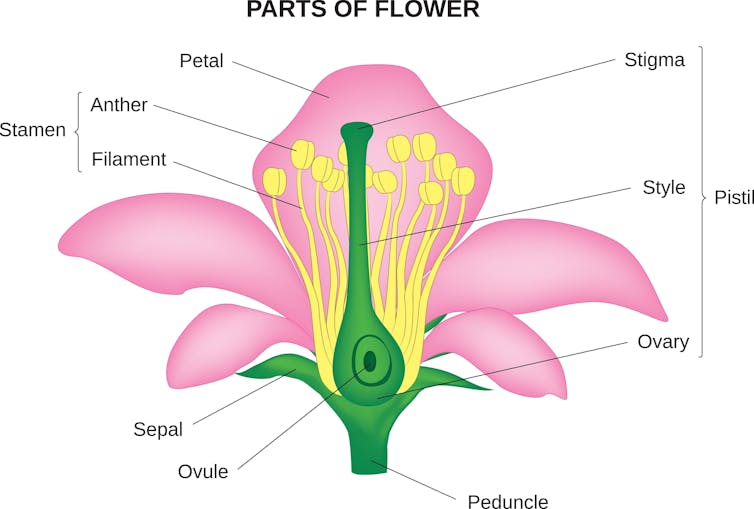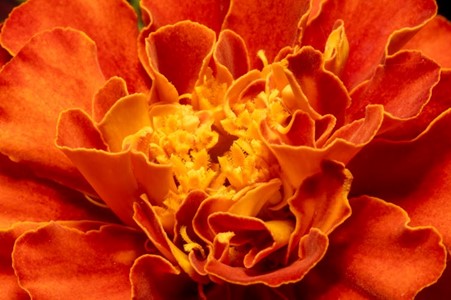In an article for The Conversation, plant cell biologists Professor John Doonan and Dr Maurice Bosch shine a light on the intricacies of reproduction in flowering plants:
You might think flowers don’t have much choice about who they mate with, given they are rooted to the ground and can’t move.
But when scientists from Nagoya, Japan used powerful microscopes to study the fertilisation process, they were surprised to find the female part of a flowering plant (ovules) could repel sperm from pollen and direct them to nearby unfertilised ovules in the same plant.
First though, it’s important to understand how reproduction in flowering plants works. Just like animals, flowering plants engage in sexual reproduction where male and female parts come together and create new life.
In both flowering plants and animals, these reproductive cells, also known as gametes, contain half the number of chromosomes found in normal adult cells. The fusion of gametes restores the normal number of chromosomes and allows the development of an embryo that can eventually develop into an adult, like the plants and people you see around you.
Most organisms produce far more sperm than eggs. In mammal reproduction, the sperm are highly mobile, and many arrive at the egg around the same time. Yet multiple fertilisation rarely happens. This would introduce unneeded chromosomes, unbalance the embryo’s genome and probably lead to developmental abnormalities including death.
Flowering plants face similar challenges in matching one sperm to one egg, but they handle it quite differently from mammals like us. Even the production of eggs and sperm in plants is more complex.
Pollen, which carries the male gametes, is produced in specialised organs called anthers. These are the oval shaped parts forming the top of the stamen. When the anthers rupture, which needs to be synchronised with flower development, mature pollen grains are exposed. These pollen grains are transferred to the female parts of the flower, often through the help of wind, insects, birds, or other pollinators. But numerous biological gatekeepers, or barriers, ensure that only appropriate pairings happen.

When the pollen arrives on the sticky receptive surface of the female part of the flower, called the stigma, which is part of the pistil, the pollen has to germinate on the stigma. It then grows down through the style, towards the egg, which resides deep inside the ovule. The pollen can only do this if it is compatible with the pistil. Just like in animals, reproducing within the family can have disadvantages in plants such as poor growth.
To avoid these issues, around 50% of flowering plant species have developed a mechanism called self-incompatibility, which helps to prevent inbreeding. For instance, when pollen and pistil proteins recognise each other as being from the same plant, a signal is sent to block the growth of the pollen tube, preventing fertilisation.
But many pollen grains can land on a stigma and germinate. So, how do plants ensure that each ovule is only penetrated by just one pollen tube? Using live cell microscopy along with special fluorescent trackers, scientists can observe and measure changes inside cells. This technology helps us understand how pollen tube growth is controlled by monitoring different aspects of cell activity, such as energy levels, acidity and cellular structures.
The recent study from Japan used advanced imaging techniques to show that protein signals guide a pollen tube to an individual ovule within the ovary, through a process called chemotaxis. Chemotaxis acts a bit like a navigation system where the growing tip of the pollen tube homes in on the source of these protein signals.
The system also ensures that each ovule pairs with just one pollen tube. The researchers found the system includes a repulsion signal too. Once a pollen tube is fixed on a particular ovule, a different signal prevents additional pollen tubes from approaching that same ovule and redirects pollen tubes to other ovules.
This precise orchestration ensures successful fertilisation and efficient seed production, which is essential for producing our food.
There’s another barrier when the pollen tube releases the sperm cells into the ovule. Most non-flowering, often referred to as “lower”, plants such as ferns, mosses and algae, have mobile male gametes that are similar to animal sperm. The sperm of flowering plants, however, have lost their mobility and are delivered to their destinations by the pollen tube which can grow at speeds of up to 1cm per hour.
Throughout its journey within the female parts of the flower (the stigma, style and ovule), intense communication happens between the pollen tube and the various parts of the pistil. The ovule secretes attractants, small proteins called LUREs, which guide pollen tubes to grow towards it. Once the tube reaches the ovule, it enters and releases its two sperm cells.
In a fascinating evolutionary twist, these two sperm perform a double fertilisation: one sperm fertilises the egg cell while the other fertilises a special cell called the central cell. The fertilised egg cell develops into the embryo that will grow into a new plant, while the fertilised central cell creates an endosperm. The endosperm is a kind of tissue that supports and feeds the embryo, much like the mammalian placenta feeds the unborn baby.
Although the endosperm is temporary in many species and the seed is primarily just embryo, in grasses, the endosperm forms a large part of the ripe seed that we harvest for making foods like bread, rice and porridge.
Plants are so different from us it is easy to dismiss them as simple. But every year scientists are learning more about how intricate and complex their lives are.![]()
This article is republished from The Conversation under a Creative Commons license. Read the original article.




